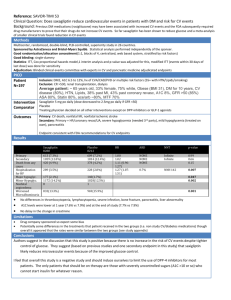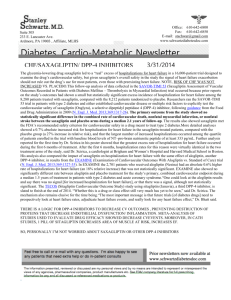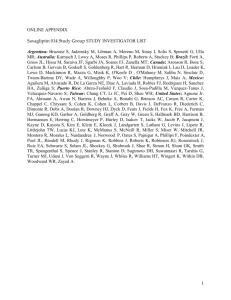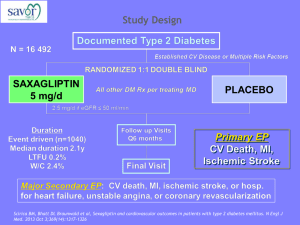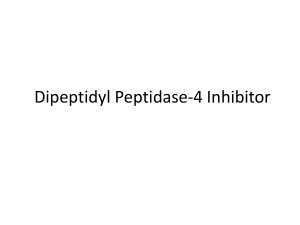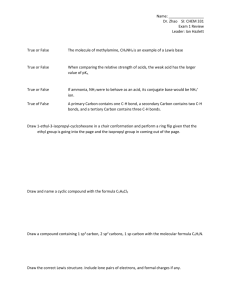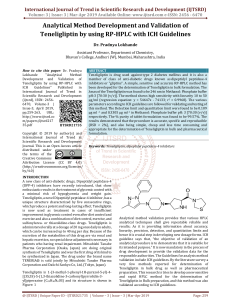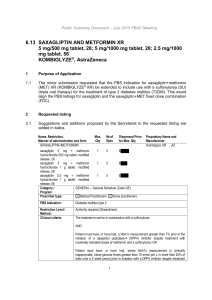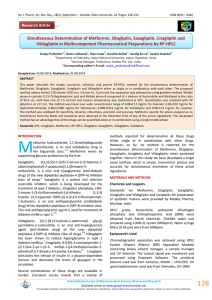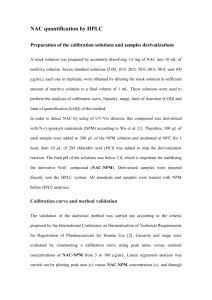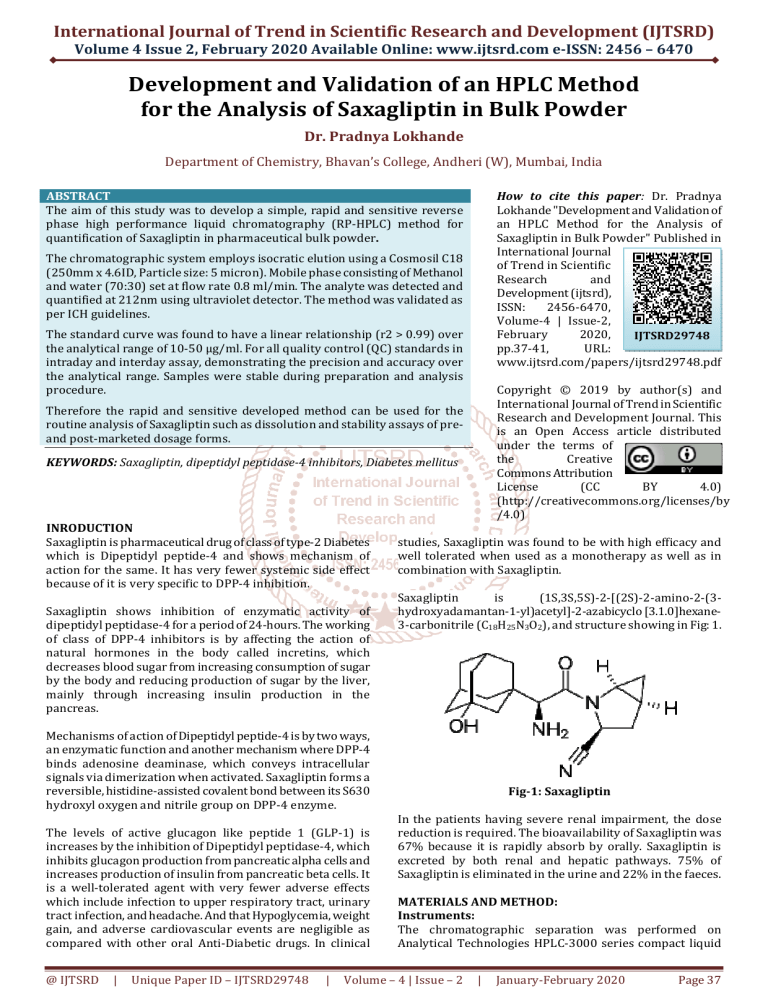
International Journal of Trend in Scientific Research and Development (IJTSRD)
Volume 4 Issue 2, February 2020 Available Online: www.ijtsrd.com e-ISSN: 2456 – 6470
Development and Validation of an HPLC Method
for the Analysis of Saxagliptin in Bulk Powder
Dr. Pradnya Lokhande
Department of Chemistry, Bhavan’s College, Andheri (W), Mumbai, India
How to cite this paper: Dr. Pradnya
Lokhande "Development and Validation of
an HPLC Method for the Analysis of
Saxagliptin in Bulk Powder" Published in
International Journal
of Trend in Scientific
Research
and
Development (ijtsrd),
ISSN:
2456-6470,
Volume-4 | Issue-2,
February
2020,
IJTSRD29748
pp.37-41,
URL:
www.ijtsrd.com/papers/ijtsrd29748.pdf
ABSTRACT
The aim of this study was to develop a simple, rapid and sensitive reverse
phase high performance liquid chromatography (RP-HPLC) method for
quantification of Saxagliptin in pharmaceutical bulk powder.
The chromatographic system employs isocratic elution using a Cosmosil C18
(250mm x 4.6ID, Particle size: 5 micron). Mobile phase consisting of Methanol
and water (70:30) set at flow rate 0.8 ml/min. The analyte was detected and
quantified at 212nm using ultraviolet detector. The method was validated as
per ICH guidelines.
The standard curve was found to have a linear relationship (r2 > 0.99) over
the analytical range of 10-50 µg/ml. For all quality control (QC) standards in
intraday and interday assay, demonstrating the precision and accuracy over
the analytical range. Samples were stable during preparation and analysis
procedure.
Copyright © 2019 by author(s) and
International Journal of Trend in Scientific
Research and Development Journal. This
is an Open Access article distributed
under the terms of
the
Creative
Commons Attribution
License
(CC
BY
4.0)
(http://creativecommons.org/licenses/by
/4.0)
Therefore the rapid and sensitive developed method can be used for the
routine analysis of Saxagliptin such as dissolution and stability assays of preand post-marketed dosage forms.
KEYWORDS: Saxagliptin, dipeptidyl peptidase-4 inhibitors, Diabetes mellitus
INRODUCTION
Saxagliptin is pharmaceutical drug of class of type-2 Diabetes
which is Dipeptidyl peptide-4 and shows mechanism of
action for the same. It has very fewer systemic side effect
because of it is very specific to DPP-4 inhibition.
Saxagliptin shows inhibition of enzymatic activity of
dipeptidyl peptidase-4 for a period of 24-hours. The working
of class of DPP-4 inhibitors is by affecting the action of
natural hormones in the body called incretins, which
decreases blood sugar from increasing consumption of sugar
by the body and reducing production of sugar by the liver,
mainly through increasing insulin production in the
pancreas.
studies, Saxagliptin was found to be with high efficacy and
well tolerated when used as a monotherapy as well as in
combination with Saxagliptin.
Saxagliptin
is
(1S,3S,5S)-2-[(2S)-2-amino-2-(3hydroxyadamantan-1-yl)acetyl]-2-azabicyclo [3.1.0]hexane3-carbonitrile (C18H25N3O2), and structure showing in Fig: 1.
Mechanisms of action of Dipeptidyl peptide-4 is by two ways,
an enzymatic function and another mechanism where DPP-4
binds adenosine deaminase, which conveys intracellular
signals via dimerization when activated. Saxagliptin forms a
reversible, histidine-assisted covalent bond between its S630
hydroxyl oxygen and nitrile group on DPP-4 enzyme.
The levels of active glucagon like peptide 1 (GLP-1) is
increases by the inhibition of Dipeptidyl peptidase-4, which
inhibits glucagon production from pancreatic alpha cells and
increases production of insulin from pancreatic beta cells. It
is a well-tolerated agent with very fewer adverse effects
which include infection to upper respiratory tract, urinary
tract infection, and headache. And that Hypoglycemia, weight
gain, and adverse cardiovascular events are negligible as
compared with other oral Anti-Diabetic drugs. In clinical
@ IJTSRD
|
Unique Paper ID – IJTSRD29748
|
Fig-1: Saxagliptin
In the patients having severe renal impairment, the dose
reduction is required. The bioavailability of Saxagliptin was
67% because it is rapidly absorb by orally. Saxagliptin is
excreted by both renal and hepatic pathways. 75% of
Saxagliptin is eliminated in the urine and 22% in the faeces.
MATERIALS AND METHOD:
Instruments:
The chromatographic separation was performed on
Analytical Technologies HPLC-3000 series compact liquid
Volume – 4 | Issue – 2
|
January-February 2020
Page 37
International Journal of Trend in Scientific Research and Development (IJTSRD) @ www.ijtsrd.com eISSN: 2456-6470
chromatographic system integrated with a variable
wavelength programmable UV detector and a Rheodyne
injector equipped with 20µl fixed loop. A reverse phase C18
[Cosmosil C18 (250mm x 4.6ID, Particle size: 5 micron)] was
used. Model - UV 2012 double beam UV visible
spectrophotometer and Wenser High Precision Balance
Model: PGB 100 electronic balance was used for
Spectrophotometric determinations and weighing purposes
respectively.
solutions. The elution was monitored by injecting the 20µl
and the flow rate was adjusted to 0.8 ml/min.
Reagents and chemicals
Pharmaceutical grade pure Saxagliptin sample was procured
from Swaroop Drugs and Pharmaceuticals, Aurangabad.
HPLC grade Methanol and HPLC grade Water were procured
from Merck specialities private limited, Mumbai.
Preparation of Sample Solution
20 tablets of Saxagliptin were initially weighed and
powdered and an amount equivalent to 10mg was accurately
weighed into a 10ml volumetric flask, mixed with 10ml of
mobile phase and sonicated for 5 min after making final
volume up to 10 ml with mobile phase. Then solution was
filtered through 0.45µm membrane filter. The solution
contains 1000µg/ml of Saxagliptin. From the above stock
solution 0.1ml aliquot was transferred in to a 10 ml
volumetric flask, volume was made up to the mark with
mobile phase to obtain a final concentration of 10 µg/ml of
Saxagliptin.
Chromatographic conditions
C18 [Cosmosil C18 (250mm x 4.6ID, Particle size: 5 micron)]
was used for the chromatographic separation at a detection
wave length of 212 nm. Methanol, water in a ratio of 70:30
v/v was selected as mobile phase for elution and same
mixture was used in the preparation of standard and sample
Preparation of Standard solutions
10 mg Saxagliptin was accurately weighed and transferred
into 10 ml volumetric flasks, dissolved using mobile phase
and the volume was made up with the same solvent to obtain
primary stock solution of concentration 1000µg/ml of the
drug (Working stock solution).
Optimization of RP-HPLC method
The HPLC method was optimized with an aim to develop a estimation of Saxagliptin. Different mobile phases were tried for the
method optimization, but acceptable retention times, theoretical plates and good resolution were observed with Methanol,
water (70:30 v/v) using C18 column [Cosmosil C18 (250mm x 4.6ID, Particle size: 5 micron)] Table:1 and a typical
chromatograph of Saxagliptin was shown in figure 3.
Parameter
Column
Mobile Phase
Flow Rate
Wavelength
Injection Volume
Detector
Run Time
Retention Time
Condition
Cosmosil C18 (250mm x 4.6ID, Particle size: 5 micron)
70 : 30 (Methanol: Phosphate buffer pH-4.8).
0.8 ml/min
212 nm
20 µl
UV-3000-M
7.5 min
Approx. 000 min
Table1: Optimized parameter
Validation of the RP-HPLC method
Validation of the optimized method was performed according to the ICH Q2 (R) guidelines.
1. Linearity
For the determination of linearity, appropriate aliquots were pipetted out from 1000µg/ml (working stock solution). 0.1 – 0.5
ml was pipetted out in to a series of 10ml volumetric flasks and volume was made up with the solvent to obtain concentration
ranging from 10-50µg/ml of Saxagliptin. Each solution was injected in triplicate. Calibration curves were plotted with
concentration against observed peak areas followed by the determination of regression equations and calculation of the
correlation coefficients. The calibration curve for Saxagliptin was shown in figure 2 and their corresponding linearity
parameters given in table 2.
2. Accuracy
To ensure the reliability and accuracy of the recovery studies were carried out by % recovery method (standard addition
method). A known quantity of pure drug was added to pre-analysed sample and contents were reanalysed by the proposed
method and the per cent recovery was reported. The results were given in table 4.
3. Precision
The repeatability of the method was verified by calculating the % RSD of three replicate injections of 100% concentration
(30µg/ml of Saxagliptin) on the same day and for intraday precision % RSD was calculated from repeated studies. The results
were given in table 5.
4. Limit of Quantitation (LOQ) and Limit of Detection (LOD)
The LOD and LOQ were calculated from the slope(s) of the calibration plot and the standard deviation (SD) of the peak areas
using the formulae LOD = 3.3 s/s and LOQ = 10 s/s.
5. Robustness
Robustness was verified by altering the chromatographic conditions like mobile phase composition, flow rate, detection wave
length, etc. and the % RSD should be reported. In the operational conditions Small changes were allowed and the extent to
@ IJTSRD
|
Unique Paper ID – IJTSRD29748
|
Volume – 4 | Issue – 2
|
January-February 2020
Page 38
International Journal of Trend in Scientific Research and Development (IJTSRD) @ www.ijtsrd.com eISSN: 2456-6470
which the method was robust was determined. A deviation of ± 2 nm in the detection wave length and ± 0.1 ml/min in the flow
rate, were tried individually. Solutions of 100% test concentration with the specified changes in the operational conditions
were injected to the instrument in triplicate. % RSD was reported in the table 6.
6. Assay of marketed formulation
20 tablets of Saxagliptin were weighed and crushed into fine powder. The average weight of the tablet was calculated and the
amount equivalent to 10 mg of pure Saxagliptin was dissolved in 10 ml of solvent. From this stock solution 30 ppm dilution was
prepared and injected. The % purity was calculated by comparing the result with result obtained from 30 ppm standard drug
and are reported in table 7.
7. System suitability
It was ensure that from the system suitability parameters, the method can generate results of
acceptable accuracy and precision. System suitability was carried out with three injections of solution of 30 µl/ml of Saxagliptin
in to the chromatographic system. Number of theoretical plates (N) obtained and calculated tailing factor (T) was reported in
table 8.
RESULT AND DISCUSSION
Linearity:
It was clarify from the analytical method linearity as the ability of the method to obtain test results that are directly
proportional to the analyte concentration, within a specific range. The peak area obtained from the HPLC chromatograph was
plotted against corresponding concentrations to obtain the calibration graph. The results of linearity study (Figure 1) gave
linear relationship over the concentration range of 10 - 50 µg/ml for Saxagliptin. From the regression analysis, a linear
equation was obtained y = 39629x + 44646, and the goodness-of-fit (r2) was found to be 0.9989, indicating a linear relationship
between the concentration of analyte and area under the peak.
Conc. (µg/ml) Peak Area
10
437246
20
863287
30
1205362
40
1622726
50
2038985
Table2: Summary of results of Linearity
Figure2: Linearity
Figure 3: Typical chromatograph of Saxagliptin
@ IJTSRD
|
Unique Paper ID – IJTSRD29748
|
Volume – 4 | Issue – 2
|
January-February 2020
Page 39
International Journal of Trend in Scientific Research and Development (IJTSRD) @ www.ijtsrd.com eISSN: 2456-6470
Accuracy
The accuracy of the method determines the closeness of results obtained by that method to the true value. From the results of
accuracy testing it was showed that the method is accurate within the acceptable limits. The % RSD is calculated for the
Saxagliptin and all the results are within limits. Acceptable accuracy was within the range and not more than 2.0% RSD, as
demonstrated in Table -3.
Sr. No.
Conc.(ppm)
10
10
10
30
30
30
50
50
50
1
2
3
Sr. No.
1
2
3
Standard Deviation
Accuracy
Area
Mean
SD
%SD
437589
437246 437430.3333 172.934477 0.0395342
437456
1208494
1205362 1207139.333
1608.2106
0.1332249
1632545
2036434
2038985 2038528.333 1907.449694 0.0935699
2040166
Table3: summary of Results of Accuracy
% Composition
50% Recovery
100% Recovery
150% Recovery
Area of Standard Area of Sample
1205362
1208921
1622726
1639656
2038985
2034615
Table4: % recovery
Precision
%RSD
0.039534176
0.133224936
0.093569938
% Recovery
100.295264
101.0433061
99.78567768
Precision
Precision is “the closeness of results obtained from multiple sampling of the same homogeneous sample under the prescribed
conditions,” and it is expressed in the form of relative standard deviation. The repeatability, intra-day and inter-day precision
results are shown in the table 5. The RSD were calculated for all the results are within limits. Precision was not more than 2.0%
RSD, as demonstrated in Table 5.
Interday
Day 1
1197654
1205362
Intraday
Morning
1205362
1219645
Day 2
1206495
1208656
1201659
1203564
Mean
%RSD
1203564
0.32%
Evening
1206659
1197654
1196523
%RSD
1206495
1205390
0.69%
Table-5: summary of Precision
LOD and LOQ
The LOD and LOQ were calculated by the equations LOD
and LOQ =
where, std. Deviation
taken from accuracy and slope is from linearity. Based on these equations, the calculated LOD and LOQ values for Saxagliptin
were 0.102 and 0.3101 µg/ml, respectively.
Robustness
Robustness of the method reflects that the results are unaffected or reliable even if the minute changes in the method
parameters. Here, the flow rate and wavelength were slightly changed to lower and higher sides of the actual values to find if
the change in the peak area and retention time were within limits. The results obtained with changes in the parameters on a
30µg/mL solution are as shown in Table No. 6.
Parameter
Flow rate
(ml)
Wavelength
(nm)
@ IJTSRD
|
conditions
0.7
0.8
0.9
210
212
214
Conc.(ppm)
Area
Mean
30
1207634
30
1205362 1205876
30
1204632
30
1201649
30
1205362 1203557
30
1203659
Table6: robustness
Unique Paper ID – IJTSRD29748
|
Volume – 4 | Issue – 2
|
SD
%SD
1565.61
0.12983211
1858.61
0.1544268
January-February 2020
Page 40
International Journal of Trend in Scientific Research and Development (IJTSRD) @ www.ijtsrd.com eISSN: 2456-6470
Assay of marketed formulation
The % purity obtained from the formulation was given in table 7. And it was found that the Assay results of Saxagliptin are
within the limits.
Sr. No.
1
% Composition Area of Standard Area of Sample
% Assay
1205362
1191981
Table7: Assay of tables of Saxagliptin
% Assay
98.8899
System Suitability Parameters:
System suitability was performed by injecting three replicate injections of 100% test concentration, number of theoretical
plate, asymmetry factor are satisfactory. The chromatographs confirm the presence of Saxagliptin at 4.2 min without any
interference.
Parameter
Observed Value limits
No. of Theoretical Plates
9520
> 2000
Tailing Factor
1.15
<1.5
Table8: System suitability parameter
CONCLUSION:
The proposed method was found to be simple, precise,
accurate, rapid and specific for determination of Saxagliptin
from pure and its dosage forms. The mobile phase used for
method development is very simple to prepare and
economical also. The sample recoveries in the formulation
were showing good results with their respective label claims
and it was found that there is no interference of formulation
excipients in the estimation. And hence, this method can be
easily and conveniently adopted for routine analysis of
Saxagliptin in pure form and its dosage form.
ACKNOWLEDGEMENT
Author gratefully acknowledges the RAP Analytical
Laboratories for their kind help and providing all necessary
facilities and thank to Mr. Rohan Pawar for the gift sample of
Saxagliptin.
REFERENCE
[1] Kalra S, Ghosh S, Aamir AH, Ahmed MT, Amin MF, Bajaj
S, et al. Safe and pragmatic use of sodium–glucose cotransporter 2 inhibitors in type 2 diabetes mellitus:
South Asian Federation of Endocrine Societies
consensus statement. Indian J Endocrinol Metab. 2017;
21(1): 210-230.
[2] ICH Harmonised Tripartite Guideline, validation of
analytical procedures: Text methodology, Q2 (R1)
(2005). International Conference on Harmonization,
Geneva, pp: 1-13.
[3] Prasad PBN, Satyanaryana K, Krishnamohan G.
Development and Validation of a Method for
Simultaneous Determination of Metformin and
Saxagliptin in a Formulation by RP-HPLC. American
Journal of Analytical Chemistry. 2015; (6): 841-850.
@ IJTSRD
|
Unique Paper ID – IJTSRD29748
|
[4] Singh N, Bansal P, Maithani M, Chauhan Y.
Development and validation of a stability indicating
RP-HPLC method for simultaneous determination of
Dapagliflozin and Saxagliptin in fixed-dose
combination. New J. Chem. 2018; 42: 2459-2466.
[5] Deepan T, Dhanaraju MD. Stability indicating HPLC
method for the simultaneous determination of
Dapagliflozin and Saxagliptin in bulk and tablet dosage
form. Curr. Issues Pharm. Med. Sci. 2018; 31(1):39-43.
[6] Reddy Padmaja B, Sivagami B, Sireesha R,
Chandrasekar R, Niranjan babu M. A Highly Validated
RP-HPLC Method Development for the Simultaneous
Estimation of Dapagliflozin and Saxagliptin in Tablet
Dosage Forms. Int. J. Pharm. Sci. Drug Res. 2018; 10(5):
372-378.
[7] Patel PD, Pandya SS. Validated RP – HPLC Method for
Simultaneous Estimation of Dapagliflozin and
Saxagliptin Hydrochloride in Tablet Dosage Form.
International Journal for Pharmaceutical Research
Scholars. 2018; 7 (1): 9-15.
[8] Bays H. Sodium Glucose Co-transporter Type 2
(SGLT2) Inhibitors: Targeting the Kidney to Improve
Glycemic Control in Diabetes Mellitus. Diabetes Ther.
2013; 4(2): 195– 220
[9] Mr. Nilesh Nikam | Dr. Avish Maru | Dr. Anil Jadhav | Dr.
Prashant Malpure "Analytical Method Development
and Validation of Metformin Hydrochloride by using
RP-HPLC with ICH Guidelines" Published in
International Journal of Trend in Scientific Research
and Development (ijtsrd), ISSN: 2456-6470, Volume-3 |
Issue-3, April 2019, pp.415-419
Volume – 4 | Issue – 2
|
January-February 2020
Page 41

